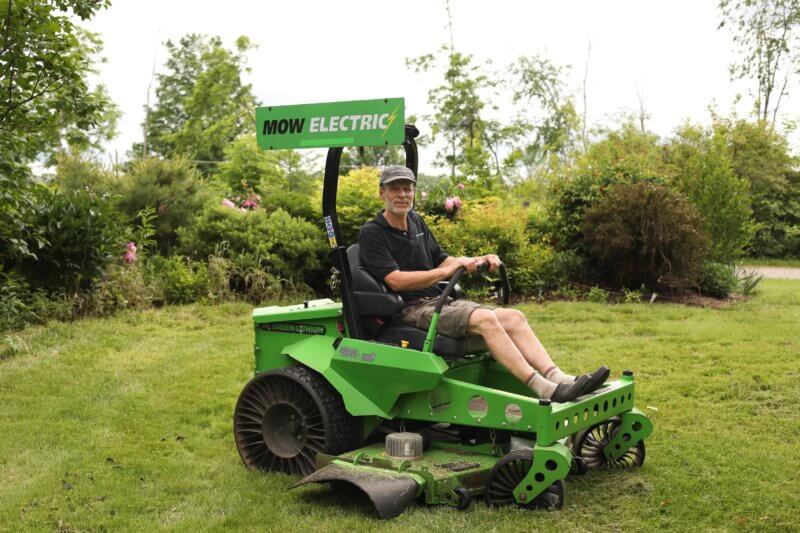E-lawncare movement gaining momentum
With the existential impacts of human-caused climate change becoming ever more obvious, it’s also more obvious that we need to do everything possible to reduce the volume of fossil fuel consumed. And while the huge quantities of gas and diesel burned in lawn care equipment hasn’t previously drawn much attention, that’s beginning to change.
A 2019 U.S. Department of Transportation report estimated that Vermonters consume approximately 5.4 million gallons of gasoline on lawn care every year, which is associated with the release of approximately 108 million pounds of CO2. And these numbers don’t even include all the diesel-powered “commercial” lawn mowers used by contractors, our public schools, colleges/universities, towns and cities, state government, resorts, golf courses, etcetera.
Commercial gas/diesel-powered riding mowers consume an average of 1 gallon of gas or diesel fuel per hour. Since burning 1 gallon of gas or diesel releases roughly 20 pounds of CO2, every commercial mower operated for 600-800 hours over Vermont’s roughly five month growing season consumes between 600-800 gallons of fuel, which generates between 12,000-16,000 pounds (6-8 tons) of CO2. Cumulatively, for every 100 of these mowers operating in Vermont, 1.2-1.6 million pounds (600-800 tons) of CO2 is being released every year.

By comparison, a typical commercial battery-electric riding mower consumes roughly 3 kilowatt hours, and in Vermont, the generation and distribution of that electricity is associated with the release of roughly 0.26 pounds of CO2. So, when a commercial e-mower is operated for the same 600-800 hours, it consumes between 1,800-2,400 kilowatt hours of electricity, which is associated with the release of approximately 468-624 pounds (almost a quarter to a third of a ton) of CO2, which is about 25 times less CO2 emissions compared to a gas/diesel mower.
Residential gas-powered walk-behind mowers have smaller engines, but they’re inefficient, so they also burn a half to a full gallon per hour, which in-turn releases 10-20 pounds of CO2 per hour. This means that for every 1,000 residential gas-powered walk-behind mowers operating in Vermont, they’re collectively releasing 10,000-20,000 pounds (5-10 tons) of CO2 per hour.
Vermonters also operate thousands of gas-powered “chore” tools including string trimmers, chain saws or debris/leaf blowers which further adds to the many environmental impacts of conventional lawn care practices.
The good news is that switching to battery-electric lawn care equipment has never been easier, and Vermonters are increasingly making this switch. There are now lots of brands to choose from, including over 20 manufacturers of e-walk-behind lawn mowers and chore tools, and six manufacturers of residential e-riding mowers. And although there’s currently only four manufacturers of commercial e-riding mowers (with run times of up to eight hours), more are coming.
While e-lawn care equipment may cost more to purchase, cost of ownership, or its “life-cycle” cost, is a lot less due to the lower cost of electricity compared to fossil fuel, and much lower maintenance and repair costs. It also eliminates the need to transport gas, is a lot quieter and has no tailpipe emissions.
To help make this equipment even more affordable, all of Vermont’s electric utilities now offer incentives or rebates for both residential and commercial e-lawn equipment based on the expected reductions in greenhouse gas emissions.
Thousands of Vermont homeowners and renters have already begun to make this switch, as has Shelburne Farms; the city of Burlington Parks and Recreation Department; the Burlington Airport; the Vermont Department of Forests, Parks and Recreation; and the University of Vermont.
The Ten Stones homeowners association in Charlotte is also now in its third season using an e-riding mower to maintain about 6 acres of private lawns, shared green space and walking trails.
While there are now about a dozen Vermont contractors offering e-lawn care services, there are hundreds more still using conventional equipment, as is the case with the majority of homeowners and renters, cities and towns, public schools, colleges and universities, state agencies and departments, museums, resorts, golf courses, etcetera.
To help facilitate the broader transition to e-lawn care, the Mow Electric! Campaign has been working with the Vermont Clean Cities Coalition, town energy committees, citizen advocates, equipment vendors, local and state government representatives, and others. The Mow Electric! website supports this work by providing links to utility incentives or rebates, links to manufacturers’ websites, interactive “life-cycle costs and CO2 emissions comparison” spreadsheets, a list of e-mowing contractors, access to “We Mow Electric” yard signs and lots of other resources. All Vermonters are invited to help bring about this important transition.
(Steven Wisbaum is the founder of the Mow Electric!)

